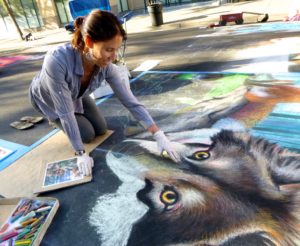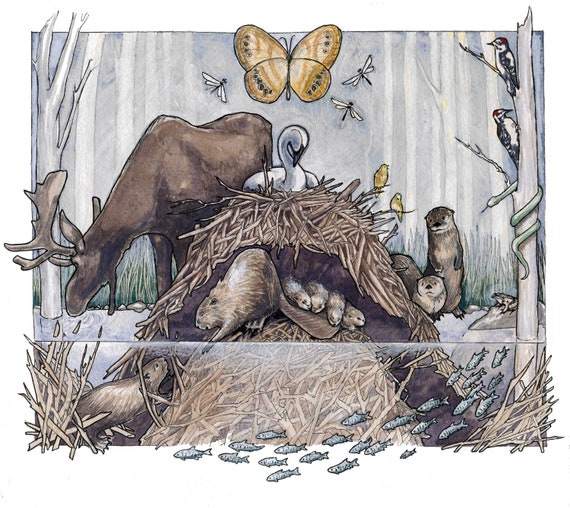Where do the days go? Yesterday we redesigned the stage musician sign and made 53 place cards so the exhibitors know where they set up camp. Oh and checked on Luigi to make sure sandwiches can be delivered to the park for our volunteers. Done, done and done.
Meanwhile I’m just stunned it took 11 long years for me to finally find the perfect ‘tagline’ for the festival. It finally just came to me while I was promoting yesterday’s article on facebook. I think this is beer commercial, madison avenue good. I played around with it a little yesterday, but I’m sure they could do something awesome with it.

I mean I suppose monkey festivals or rat festivals have a tail too, but they’re not here to defend themselves so I win! I never heard of a rat festival anyway but I bet there is a monkey one. Don’t you? I saw several species in Costa Rica but what I remember most about monkeys comes from a badly tended large cage when I was a teen on a spring trip to Mexico. There was a friendly adult and young monkey that would wrap their arms around you tightly if entered the cage, holding on for dear life. I guess it was boring in that cage. Or maybe they just knew that if they held on tight they had a better chance of bolting once the gate was open again,
All I know is that I quickly learned the only way OUT of the monkey cage was to get some other poor sap to come in and receive the eager primate hug so you yourself could make a break for it. It turns out there are many situations like that in life, and I remember the lesson well.
Just so we remember it’s not all sunshine and roses in a beaver life, lets take a fast visit to South Dakota.
South Dakota battles problems with beavers
 MITCHELL (AP) – In the spring, Randy Becker’s workload gets busy. Busy as a beaver, you might say.
MITCHELL (AP) – In the spring, Randy Becker’s workload gets busy. Busy as a beaver, you might say.
Becker is wildlife damage specialist for the South Dakota Game Fish & Parks Department. His job, otherwise known as “state trapper,” involves ridding nuisance animals like coyotes and beavers for South Dakota landowners. Yes, beavers – those little semi-aquatic rodents that can cause “a world of headaches” – are a big problem here.
“They’re an amazing animal, but they get themselves in a lot of trouble,” said Becker, who’s worked for GF&P for just shy of a decade.
In the past five years, GF&P’s Animal Damage Control program has received an average of 370 beaver calls annually statewide, The Daily Republic reported. The total funding spent removing beavers has climbed, too, and reached a peak in 2017 of $213,800. Since 2013, GF&P has spent nearly $1 million on removing beavers in South Dakota.
214,000 to kill 370 beavers? Wait, that’s like 60 dollars per beaver. Who gets paid 60 dollars a tail? If you consider 5-7 beavers per family then killing off a single colony is nearly 500 dollars a pop! You know what else South Dakota could do with 500 dollars? I mean besides open health care clinics, provide childcare and fix all the potholes. They could install flow devices that fix beaver problems for a decade, fire Mr.Becker (who will certainly never be able to take vacation in England with a name like Randy Becker) and do something useful with that million dollars every 5 years.
But hey, why FIX a problem that pays so well to stay broken?



 No more pre-orders. It’s out. I just got a notice from Amazon that its on its way. Hurray!
No more pre-orders. It’s out. I just got a notice from Amazon that its on its way. Hurray! and popular things, from a day-long musical lineup that includes bluegrass and Dixieland bands, a nature-themed silent auction, the return of beaver tours and special activities for children.
and popular things, from a day-long musical lineup that includes bluegrass and Dixieland bands, a nature-themed silent auction, the return of beaver tours and special activities for children.




 The results of some million-dollar-a-mile geoengineering looked suspiciously like a toddler was at the controls of the bulldozer. Every tree for 50 feet on either side of the little creek was knocked over. Scraggly willow shoots poked out of No-Man’s-Land rock piles. Weird reddish-orange scum floated on stranded ponds.
The results of some million-dollar-a-mile geoengineering looked suspiciously like a toddler was at the controls of the bulldozer. Every tree for 50 feet on either side of the little creek was knocked over. Scraggly willow shoots poked out of No-Man’s-Land rock piles. Weird reddish-orange scum floated on stranded ponds. But that required overcoming a lot of misperceptions about beavers. Lewis and Clark hadn’t even made it back east to St. Louis in 1806 with their report of the Voyage of Discovery when they met beaver trappers heading west. Barely 50 years later, almost all the beaver in the West were trapped out.
But that required overcoming a lot of misperceptions about beavers. Lewis and Clark hadn’t even made it back east to St. Louis in 1806 with their report of the Voyage of Discovery when they met beaver trappers heading west. Barely 50 years later, almost all the beaver in the West were trapped out. Trout Unlimited researcher Christine Brissette studied the Ninemile water flows before and after the stream restoration and beaver activity occurred. She found more natural floodplains, enhanced by beaver ponds, stored much more water and kept tons of sediment out of the Clark Fork.
Trout Unlimited researcher Christine Brissette studied the Ninemile water flows before and after the stream restoration and beaver activity occurred. She found more natural floodplains, enhanced by beaver ponds, stored much more water and kept tons of sediment out of the Clark Fork.




































